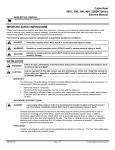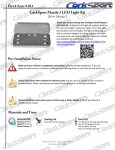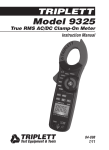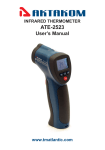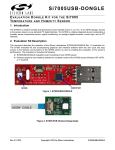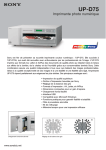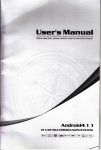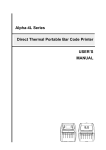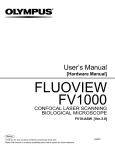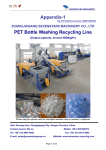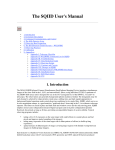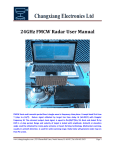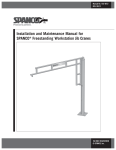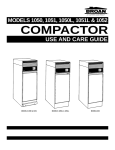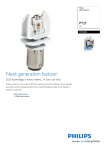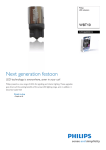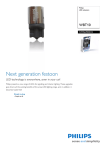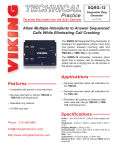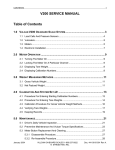Download Aero-Motive Support FAQs - Aero
Transcript
Aero-Motive® Support FAQs Mobile Electrification 1. Aero-Motive has three types of mobile electrification products: cable reels, festoon and Pow-RFeed, a multi-bar conductor system. What are the factors I should look at to assess which product is right for my application? Factors to look at to assess which product to use include: the amperage requirements of the equipment, the number of conductors needed, any space constraints or travel requirements, and the transmission of power needed (vertical or horizontal pay out) Cable reels are able to do both vertical and horizontal payout. They are able to handle up to 200 amps and can accommodate from 2 to 36 conductors. Reels can handle speeds of 200 fpm or less, but travel is limited to 320 feet or less. Festooning is for horizontal payouts. Festoons can handle most low to high amp cable, providing it fits into the window opening of the intended carriers. In some cases several flat cables can be stacked on top of each other or put side by side. Loop depth can vary from 2 to 20 feet. Festooning travel can be from 5 to 500 feet, with speeds of 400 fpm or less. Pow-R-Feed is for horizontal payout. It is able to handle amp requirements up to 160 and can have 3 to 7 conductors. Higher amps and conductors can be achieved by paralleling two or more Pow-R-Feed systems. Pow-R-Feed systems are able to have almost unlimited travel and can handle speeds up to 1000 fpm. 2. When would you typically use a cable reel as opposed to Pow-R-Feed or festoon? A cable reel would be used when a portable power supply is needed (for lighting, power tools, etc.) A cable reel would be used when a vertical application is required. Cable reels would be used when there is no supporting structure for a Pow-R-Feed or a festoon system. Cable reels would also be used when travel is other than one strait line. They would also be used for explosion proof applications. Cable reels are an economical way to optimize space for better productivity. 3. When would you typically use Pow-R-Feed as opposed to festoon or cable reel? Pow-R-Feed can be used as opposed to festoon or cable reel in the following applications: o High speed automated storage and retrieval system applications for both power and data signals. These applications can be found in paper mills, clothing facilities and warehouses that receive and ship various products. o Pow-R-Feed can form curves which makes it a perfect fit for monorail systems. These applications can be found in such places as the entertainment industry, zoos, and in window cleaning machines. o Overhead cranes which require continuous duty, low downtime and minimal maintenance. The steel mills are a great example of where this application can be found. o Plant automation and continuous testing applications where multiple signal and uninterrupted operation are important. These applications can be found in auto assembly facilities, and facilities that produce electronic and computer chips. o Pow-R-Feed can also be used in applications which the environment is a concern. For example, environments that have high levels of dust or dirt in the manufacturing process, such as cement factories, steel mills, textile and paper mills. o Pow-R-Feed can be used in applications with a long travel distance that a festoon or cable reel would not be able to fulfill. 4. When would you typically use festoon as opposed to Pow-R-Feed or a cable reel? You would use a festoon system instead of Pow-R-Feed in slower moving applications. The maximum speed of Pow-R-Feed is 1200 fpm versus the maximum speed of a festoon system at 600 fpm. You would typically use a festoon system with an application that involves a large number of cables and/or hoses. Festoons are best for high voltage and high amperage requirements and where sliding contacts can not be tolerated. Page 1 of 4 5. I need to provide power to a revolving piece of equipment. Does Aero-Motive have products to assist? Yes. You may want to consider our slip rings. We manufacture slip rings in amperage ratings from 30 to 700, in 2 to 36 conductors and with or without enclosures. Call us at 1-800-999-8559 for selection assistance or to request our current catalog. 6. I have a pendent station that needs to be lifted. What options does Aero-Motive offer? Some applications require a pendant station. Aero-Motive offers a line of torque reels that can be used in such applications. Aero-Motive torque reels are designed to suspend push button pendent stations. We also offer a line of motorized cable reels (series 4100) that can be used in pendent station applications. The Series 4100 is a heavy-duty reel used on cranes to raise and lower push button pendent stations. Call the factory at 1-800-999-8559 for additional information and pricing. Cable Reels 1. Does Aero-Motive make cable reels that are not on the web site? Yes. There are many simple modifications we can make to our cable reels to customize the reels to your application. o Silver contact type slip ring option for low voltage communications o Stainless fastener option for corrosive locations o Combination power and control slip rings in a single reel air motor driven cable reels o Limit switches to count spool turns o Reverse rotation on most models o Slip ring enclosure heater for condensation issues o Low temperature grease for freezer locations We can select a reel if you have a special cable type other than the SO or W type cable listed in our selection charts (example: soaking pit cable, Siemans Cordaflex, SDN, etc.) If you have special space restrictions and the standard reel will not fit, we can review all possibilities from our broad range of products and, if needed, offer a custom reel for your application. 2. My plant is down due to a cable reel problem and I need emergency help. How do I get assistance and how long will it take to get it fixed? Aero-Motive has a reel solutions program that provides technical assistance 24 hours a day 7 days a week. Simply call 1-616-381-9028 for emergency assistance. We can provide parts or a suitable replacement reel in 48 hours. Incremental expediting fees are applicable on replacement reels. 3. The spool on my reel is only half full of cable. Can it pickup more cable? Maybe. In addition to having the appropriate size spool, the spring(s) must provide enough tension and turns to wind the cable. If you already have the reel, check to see how many more turns you have available. You should at least have a couple safety turns left when all the cable is pulled out. If you don’t have enough turns then it is possible 4. I need to put 50 feet of #16/3 cable on a reel that has 40 feet of #14/3 cable on it currently. The model number is 0951-04-203. The #16/3 cable is smaller in diameter so can I put 10 feet more of cable on the reel? The reel for #14/3 cable has a different spring. The existing spring does not have enough turns to retract 50 feet of #16/3 cable. You can replace the spring in the reel with a spring with more turns and then the 50 feet of #16/3 cable will work in the reel. The new spring number is H41220075. 5. When do I need a ratchet lock on a reel? A ratchet lock is much like the locking mechanism on a window shade that keeps the shade down once you’ve let go. If you are manually pulling out the cable then you will probably want this option. On our smaller reels (RI, CW, 0951 and 1051L models) this comes standard and can be disengaged. On our larger reels (1100 to1400 series) this is an option. If you forget to order it, the reels will need to come back to us for retrofitting. Ratchet locks on these larger reels also need a roller guide and cable ball stop to stop the cable when totally retracted. 6. The reel the catalog shows for my application is just too big. Is there a smaller model? Generally, the reel shown is the only one available. There are some smaller specialty cables available Page 2 of 4 that can in some cases reduce the size of the reel but, if you have a 100 ft. travel required and you’ve selected a 100 ft. reel there is another option. Consider a midpoint feed. In this case you connect the power at the midpoint of the run and the reel pays-out to either side of this midpoint. Then the reel only needs to be for 50ft. Instead of 100ft. The use of a pivot base may help, if you decide to mount the reel stationary. 7. Can I order a 0951 reel without a ratchet lock? The ratchet lock can be easily disengaged; instructions are included in the service manual. Festoon 1. I like the wire rope system, but would like a longer travel than shown. Is this possible? The wire rope systems are indeed a good value and easy to install, but are not the best choice for all applications. Wire rope systems are best for hand operated hoists and other slow moving, moderately used equipment. The main reason for limiting travel on these systems is to minimize the sag in stretched rope. Undue sag will inhibit proper operation of the cars. Also longer systems require more carriers at a certain point the wire rope system doesn’t work 2. Why use flat cable on a festoon system? Flat cable has several advantages over round cable. The main benefit is one can usually use a smaller carrier than with same round cable since the minimum bend radius of flat cable can be 1/3 or less of the round. Since the bend radius is tighter and all the conductors are in one plane, flat cable will easily compress into a ribbon shape when in storage. Round cable has a tendency to twist and sometimes catch on other loops. The flat design also makes it easy to stack multiple cables into a compact package. 3. Does Aero-Motive have I-Beam Festoons and can I get it pre-installed? Yes. Aero-Motive does have festoon carriers available for I-beams and can ship out a festoon system partially assembled. We are able to install the cable on the carriers and then have the carriers put on an I-beam. When this package ships out to the job site the contractor can hoist this system up and roll the carriers and cable on to the I-beam. Aero-Motive does not sell I-beams. Pow-R-Feed 1. Why would I want to use Pow-R-Feed over other bar conductor products on the market? Pow-R-Feed has many advantages but the most important is the continuous conductors and the ease of installation. Many systems have conductor joints at each housing section joint. These joints are points of resistance as well as contributing to extra brush wear. The continuous free-floating conductors eliminate the problem of conductor joints pulling apart. The installation is also much quicker. Housings come in 4meter lengths, are mounted without conductors and slide into support hangers. After all the housings are installed, conductors are pulled quickly from end to end. Trolleys are then inserted into housing and all power connections completed. Aero-Motive has an installation video if you are interested in seeing how it is installed. 2. I want to extend a Pow-R-Feed system in the future. Will that affect how I set up the initial system? Probably! The important feature of Pow-R-Feed is its ability to freely expand and contract. The conductors must be able to slide independently of the housing. Adding on to the end of an existing system requires right angle splicing of the conductor. This will fix the conductor to the housing at the splice. The conductors are also fixed at the power feed and so they cannot freely float since connected at both ends. One solution is not to splice but install all new conductors. The other is to engineer the system to be a line feed at the future extension end. This second option will require a special ALRN7 line feed housing. Please call for a complete list of materials. Balancers 1. How do I determine which weight range of balancer is right for my applications? The weight range of balancers is determined by the weight of the tool or object being suspended. For example, if you are looking to balance a 15 lb tool in an application where heavy abuse may occur, you would want to use the 20EA over the BF18. The weight ranges are similar for both. The BF18 has a range of 13-18 lbs and the 20EA has a range of 12-20 lbs. Due to the severe service of the application, Page 3 of 4 the 20EA has a cast aluminum housing and cover compared with the plastic composite housing of the BF series. For this example the 20EA would be the balancer of choice. 2. What is the difference between a true balancer and a retractor? A true balancer allows the user to move the suspended tool or object up or down with very little effort. A balancer is able to achieve a true balance at any position within the active cable travel. A retractor is designed to retract the cable or tool out of the way of the worker. A light amount of force is needed to keep the object suspended at the desired position. 3. When should a severe service balancer be used? Severe service balancers are perfect for the support of production tools in demanding applications. They should be used when balancers are banging against each other or fixed objects. Severe service balancers have cast aluminum housing and covering that provide added strength. 4. Can I use a balancer like a hoist, to lift and transport items? A balancer, unlike a hoist, has a constant pulling force to equal the weight of the tool. If a load is disconnected then one must hold on to the cable. This is very dangerous, especially on some of the larger balancers. One could use the manual drum when changing tools(loads) but it is not intended for frequent engaging. The main purpose of a balancer is to be connected to a constant load, a tool, and to facilitate its handling. 5. Why would I want to use the bullard hook option with locking gate on the larger balancers? The bullard hook offers several advantages. First it makes the unit easy to remove and replace. The standard mounting uses a shackle with bolt and nut. To safely remove and install it may require 2 people. With the bullard the balancer is simply hooked into place and gate is then locked. A simple oneperson operation. The lower bullard offers a more rugged hook with a positive locking gate. In especially severe applications it may provide greater security against accidental unhooking. 6. Is the B balancer still available? No, but we have other balancers that have the same weight capacity. Please see the RB and RF Retractors in the catalog. Hose Reels 1. Can the D70A handle 3/8 inch hose? Yes, but only for 35-foot applications. Page 4 of 4




